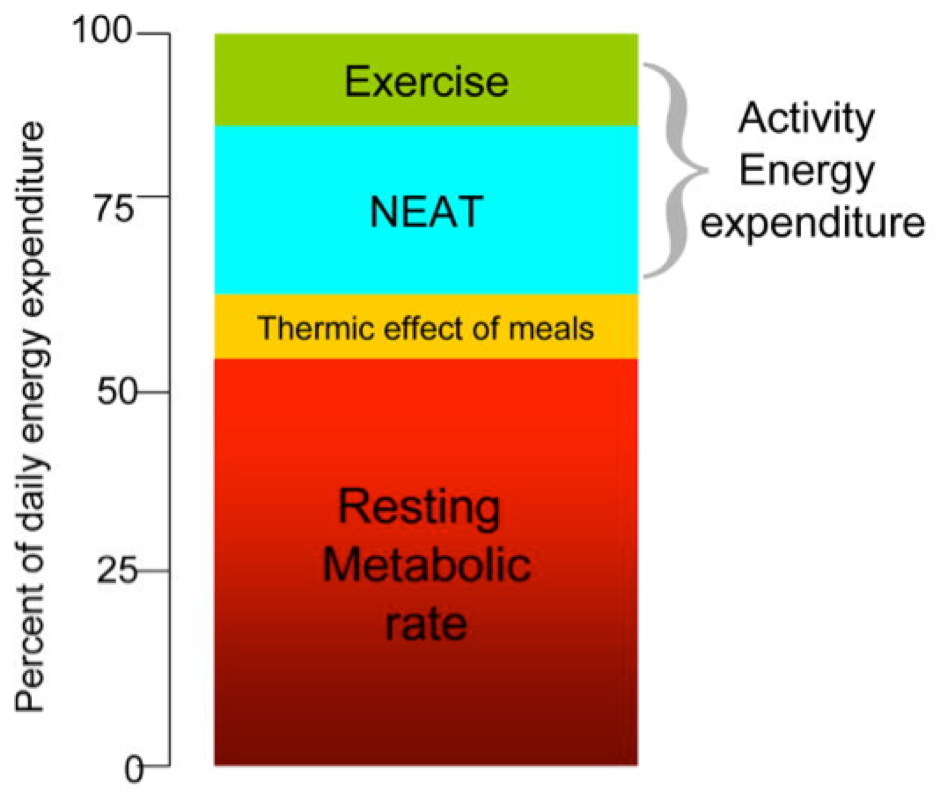If you are looking for success in the long term with your weight loss goals, then NEAT is one of the most valuable tools in your toolbox. Read on to find out more about what NEAT is, what happens to NEAT when you lose weight, why it is important for your weight loss success and 5 top tips to increase NEAT.
Recall energy balance
To lose weight, requires being in a negative energy balance through reducing energy intake and increasing energy output. The largest component of energy output is your resting metabolic rate (RMR) which is your energy output at rest. The main way in which you can influence your RMR is through increasing lean muscle mass. NEAT (non-exercise activity thermogenesis) however, is a key component of your energy output that you can influence and a day-to-day basis.
What is NEAT?
NEAT stands for non-exercise activity thermogenesis which is the energy that you expend not included in your formal physical activity/exercise. Therefore, if you count your formal exercise as going for a brisk 40 minute walk, a HIIT session or some weight training, then the NEAT would be your other movement throughout the day – so from fidgeting, to getting up and down from your seat, to gardening and hoovering. Often anything that increases your general unconscious step count and daily movement.
How much NEAT can vary…
Levels of NEAT can vary between individuals quite drastically. Ever wondered why your friend can put away a lot of food and not gain weight? Likely to be NEAT! It is thought to be one of the main reasons why some people gain weight easily and others do not. A study where individuals were over-fed by 1000 calories per day showed that there was a 10-fold difference in fat gain between individuals –some of them did not gain any weight whereas others did (Levine et al. 1999). Although these differences in NEAT are partly thought to be genetic, NEAT is something that you can consciously influence.
Why is NEAT important for your weight loss success?
If you consider that differences in NEAT could account for anywhere between 100-800 calories burned throughout the day (Ravussin et al. 1986), then this can make a considerable difference to your weight loss success. NEAT may be a significant contributor to a reduction in metabolism during dieting and long-term weight loss maintenance relies on being able to maintain that energy balance at a lower overall energy cost (Loeffeholz et al. 2018). The largest study to compare those who were successful at maintaining their weight loss (maintainers) versus those who regained weight (regainers) showed that the maintainers were significantly more active than the regainers!
7 top tips to move more through the day
1. Hit a daily step count through the day
Whilst this one may not be the most fun, it’s an objective way to measure some form of movement and track where you are. It’s likely that as you lose weight you will want to move less and therefore by tracking your steps you can mitigate this risk. Shoot for a daily count of 10000. Alternatively, work out how many steps you perform on average and start by increasing that by 20% so you can increase steps in stages.
2. Park at the furthest away point you can
If you drive to the supermarket, then park at the farthest away point. Do the same for anywhere you drive to. It all adds up. If you travel by tube or bus, get off a stop or two early and walk the rest of the way.
3. Set a timer on your phone to get up every 50-60 mins and move around
Even if it just to get up and get a glass of water. Moving around regularly will also keep you feeling energised.
4. Take a walk either before or after breakfast, lunch and/or dinner. This can be a great way of increasing steps, lowering stress levels and even supporting digestion, bowel motility and reducing bloating.
5. Incorporate evening daily house activity: hoovering/ gardening/taking the bins out
It can be easy to sit around in the evening after a long day at work, but especially if you’ve been sitting around most of the day, it’s even more important to get some movement in. Hoovering, gardening, cleaning, whatever it is!
6. Incorporate periods of standing while working. This will require more muscular effort than sitting and may also help with posture and preventing muscle imbalances caused by desk bound work.
7. Consider walk and talk meetings. Whether on your phone, with a colleague or a social meet up try and get outside and add those additional steps to your day. Maybe change from meeting at the local coffee house to the local park.
Key takeaways:
Consistent daily movement is important for long-term weight loss success: therefore, after you’ve created your personalised nutrition plan to follow, along with an exercise program, include daily movement to set yourself up for success.
Make a structured plan to include daily movement (NEAT): if you have a plan, you know what to stick to and you can track your success. Successful weight loss and maintenance of weight loss is a journey and creating healthy habits that sustain this are integral to this. With a plan, you can make adaptations as you track towards your long-term goals.
Remember that weight loss is a journey and adaptation is a critical part of this: as you diet and lose weight, your body will adapt and therefore being able to adapt your diet, exercise and daily movement are all crucial parts of making weight loss successful.
Work with a weight loss specialist
Our clinicians specialise in weight loss. All qualified nutrition professionals have backgrounds in the exercise industries and a vast amount of experience coaching clients towards their goals.
Check out our weight loss specialist page, where you can learn more about our services, clinicians and the support and programs that we offer.
If you would like to enquire to work with one of our practitioners, please click the button below:
References
- Levine et al. (2003). Non-exercise activity thermogenesis.
- Levine et al. (1999). Role of non-exercise activity thermogenesis in resistance to fat gain in humans.
- Ravussin et al. (1986). Determinants of 24-hour energy expenditure in man.
- Loeffelholz et al. (2018). The role of non-exercise activity thermogenesis in human obesity.



